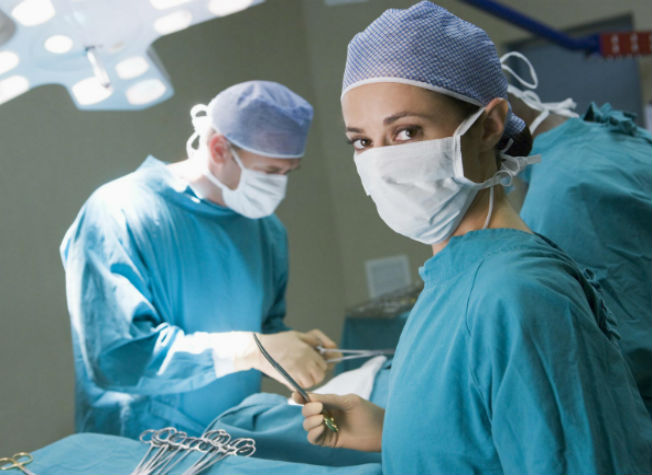Cesarean Section, Reasons, Risks And Best Ways to Avoid!
What is a Cesarean Section:
A Cesarean section (C-section) is surgery to deliver a baby. The baby is taken out through the mother’s abdomen. In the United States, almost one in three women has their babies this way. Some C-sections are planned, but many are done when unexpected problems happen during delivery.
Reasons for a C-section may include:
- Health problems in the mother.
- The mother carrying more than one baby.
- The size or position of the baby.
- The baby’s health is in danger.
- Labor is not moving along as it should.
- The surgery is relatively safe for mother and baby. Still, it is major surgery and carries risks.
- It also takes longer to recover from a C-section than from vaginal birth.
- It can raise the risk of having difficulties with future pregnancies.
- Some women may have problems attempting a vaginal birth later.
- Still, many women are able to have a vaginal birth after cesarean (VBAC).
Risks Involved In Cesarean Section:
It is generally safe for both mother and baby but is a major surgery with many risks. Moreover, recovery takes a long time than in normal delivery.
Threats With C-Section:

The incision made during surgery may leave a week spot in the wall of the uterus. This, in turn, can cause complications in vaginal delivery after the next pregnancy. However, more than half of women who previously have been operated on for childbirth can have normal deliveries afterward but with a few problems that can be well handled.
A. For Mother:
C-section can pose these threats to mother:
- Infection in the uterus or neighboring pelvic organs such as the kidney or bladder is possible to occur.
- Blood loss is double as compared to normal delivery. It is naturally increased as new blood cells are continuously being formed.
- Reaction to anesthesia, Mother’s health could be at a dangerous point due to anesthesia or the use of several medications during surgery. Blood pressure quickly drops sometimes that is hard to treat right at that moment.
- Respiratory problems such as pneumonia can be caused by a general anesthetic procedure.
- Longer recovery duration is another risk that is certainly faced by every woman undergoing a C-section childbirth.
- Additional surgeries: It is very likely to have the need for more surgeries as a consequence such as a bladder repair, hysterectomy, and others. C-section
B. For Baby:
There are certain risks to the baby as well during a surgical delivery:
- Premature birth: When the due date is miscalculated, an early delivery can occur. The week baby then is kept in a special caring unit unless it attains normal weight and completes the normal term.
- Breathing complications: Transient tachypnea, a disease characterized by abnormally fast breathing during the first several days after birth can leave adverse effects on a baby.
- Injury: Fetal injury is rare but possible. The surgeon can mistakenly affect the baby while making a uterine incision.
How to Avoid C-Section?
Here are the top things that will improve your chances of a natural birth and help you avoid an unnecessary surgical birth.
1. Select Your Birthing Facility and Doctor Carefully:
Birthing in a facility or with a doctor that has a higher percentage of C-sections increases your chance of having one. It is important your birthing facility has the same beliefs that you do and supports your desired birthing method.
Different birthing facilities can have radically different C-section rates. The chances for an individual to have a C-section is strongly correlated with the birthing facility.
2. Avoid Induction:
- If your body is not ready to give birth and you are forced into labor it can lead to a painful and non-progressive labor.
- C-section rates go up with induction rates.
- Avoiding induction is especially important if you are a first-time mom.
3. Do NOT Get an Epidural:
Epidurals commonly slow or stop labor leading to a “failure to progress” diagnosis and surgical birth to follow. They can also be the source of fetal distress leading to a cesarean birth.
4. Stay Off Your Back:
- Lying on your back or being semi-seated are the worst possible positions for giving birth.
- Do not get into either of these positions during labor or during/throughout delivery.
- Lying or sitting on your back decreases the size of the pelvis and may result in cephalopelvic disproportion or being told: “your pelvis was too small to birth vaginally.”.
5. Plan to Have a Natural Birth:
No inductions, no epidural, no manual water breaking, no c-sections, and no early hospital admittance. When unnecessary, these intrusions to the natural birthing process only further complicate labor. Allow your body to birth the baby at its own rate and timing. Only allow medical intervention when absolutely necessary. A medical intervention that occurs when it is not necessary greatly increases the change of a cesarean section.
6. Employ a Doula:
Having a female support person who is familiar with what happens during labor and birth, a Doula decreases the rate of cesarean by 50 %. Having continuous support focused completely on your family and your goals will improve your outcomes and your satisfaction with your birth.
7. Educate Yourself:
Proper education will go a long way to help you know what to expect and be prepared for the natural birthing process. This will help you be prepared when labor begins and will help you to relax. The more relaxed you are the better things will go. Relaxing and giving in to your natural instincts all help to ensure your natural birth goes smoothly.
8. Push Only When You Are Ready:
When your body is ready to push it will push. Being told to push is not only unnecessary but can be harmful. Often women are forced into the pushing stage just because they have reached ten centimeters dilation. The hospital only “allows” you to push for a specified period of time before they will recommend cesarean surgery.
9. Say NO to Continuous Fetal Monitoring:
- It may seem counterintuitive but continuous fetal monitoring has not been associated with improved birth outcomes.
- No fewer moms or babies die when using continuous monitoring versus intermittent monitoring.
- The big difference between the two forms of monitoring is that the rate of c-section, forceps, and vacuum-assisted deliveries increases with continuous monitoring.
10. Avoid Vaginal Exams:
Vaginal exams are not very useful in labor. The significance of how dilated you are is pretty minimal. Some women go from 3 cm to birth in 2 hours and some go two weeks at 6 centimeters.
- If you are having vaginal exams you will be expected to progress at a rate of 1 cm per hour or will be told you must be 10 cm by a certain time.
- If you do not fit this linear, one size fits all timeline, you will be labeled as “failure to progress” and will be told you must have a c-section.
11. Stay Home as Long as Possible:
Staying home as long as you can is a key to a successful delivery. Presenting to the hospital in early labor increases the likelihood that you will have a birth filled with interventions. The longer you are in a hospital setting the more interventions you will be exposed to. Every intervention increases the likelihood of cesarean birth.
In Case of Caesarean Section:
having a cesarean is a big deal. It is major abdominal surgery except that with a C-section you also have a baby to look after at the end, so how do you reduce your C-section pain enough to cope with the demand of your bub and still recover properly?
Anyone that has undergone, or about to have a cesarean section is naturally worried about the C-section pain that comes with this type of delivery so let’s take you through what to expect and how to avoid anymore post C-section pain than is necessary.
To start with there will be the pain from the surgery, but this will be controlled by the painkillers that you receive via your IV line. Once you are out of surgery and back up to the ward you may stay on these for another few hours, depending on how your recovery is going.
After These,
First few hours you will be offered some sort of post-C-section pain relief – usually in the form of a tablet or capsule – do not refuse these! At this early stage, it really is a matter of minutes between feeling OK and excruciating pain. While you are in pain it is impossible to heal, so stay on top of your medication.
As You Heal From The Surgery,
You will notice other types of C-section pain kicking in. These sensations can be varied, depending on how the surgery went and how complicated it was. For example getting a tubal ligation with your cesarean makes your recovery far longer and is more painful in the long term so you will need to be on your pain relief for longer.
As The Weeks Go,
by you may also experience a numbness or itchiness around the scar as the nerves take their time to heal. It takes a good six months to fully recover from your cesarean and in some cases it can take up to a year before your C-section pain is fully resolved, but here are three tips that will help you to heal faster and reduce the level of your pain.

3 Tips to Reduce Your C-Section Pain:
1. Move:
Movement is the number one way to reduce C-section pain after surgery.
To heal faster, reduce swelling and remove excess fluid you need your blood to be flowing throughout your body.
- So get moving as soon as your catheter and IV line is out – even gentle coughing is classed as moving!
- So as soon as you can, get up and go for a walk around your bed.
- Gradually increase this to walking around your room.
- However you do it, just start moving as soon as possible.
2. Use Support:
Your tummy muscles have been cut, so until they have a chance to knit back together you need to reduce you C-section pain by supporting them. The best way to start is by holding a pillow hard up against your tummy with your arms when you need to use your stomach muscles – like moving from lying down to sitting, when walking and when coughing.
3. Avoid Irritants:
There are three types of common irritants that cause us far more C-section pain than we need to experience:
- Over-using the muscles: You should lift nothing heavier than your baby for the first six weeks and avoid overstretching. This will allow your muscles time to knit securely back together and reduce the amount of post-C-section pain in that area.
- Wound irritation: avoid low cut or narrow waistbands. These will cause you great C-section pain as they irritate the wound and the area above. Choose ‘granny undies’ or even disposable undies while your scar heals over.
- Intestinal: One C-section pain that is not often talked about is in your intestines. Usually, during a cesarean your intestines are moved around a lot and can take a few weeks to recover, so avoid gas-causing foods and drinks.
C-Section Tummy Scars Treatment:
- Cesarean section or c-section scar is mostly not noticeable to other people. Nevertheless,
- it can impact a woman’s style of dressing, her self-esteem, and more importantly, her health.
- The c-section incision is generally 4 to 6 inches in length and depends on the state of the woman’s body and health.
- The scar is made at the lower part of the abdomen.
- In spite of the fact this specific scar is hidden, there are still a lot of women who will pursue a scar treatment.
Before Starting a C-Section Scar Treatment:C-S
- Curing the wound should be the principal focus.
- Wounds should be taken dealt until they are totally healed.
- Furthermore, only well-cared wounds will allow for speedy recovery and scarring.
- On the other hand, if wounds are exposed to filth and bacteria, then complications can arise and will require being dealt with first. C-SECTION RECOVERY
When wounds are not yet closed and cured, c-section scar treatment should not be applied. Commonly, with good treatment, smooth skin can be achieved subsequently after the surgery. This can be possible when the wound is almost healed and shaping a scar. This is also when scar treatment should begin.
Today,
Silicone scar treatments are one of the best treatments offered in the market:
They are available in gel and in sheets. For a c-section scar, it is best to apply silicone sheets because they can treat a larger area.
- These sheets assist in reducing swelling and redness of the scar.
- Additionally, it also helps to ease the pain and itching.
- Similarly, it can also keep the scar from bulging and turning into a keloid scar.
- When purchasing silicone sheets, it’s best to assess the length of the c-section scar.
- The length of the scar will give an idea of the size of the sheets to buy.
How to Treat Your C-section incision?
During the C-section recovery process, discomfort and fatigue are common. To promote healing:
- Rest when possible: Try to keep everything that you and your baby might need within reach. For the first couple of weeks, avoid lifting anything heavier than your baby.
- Support your abdomen: Use good posture when you stand and walk. Hold your abdomen near the incision during sudden movements, such as coughing, sneezing or laughing.
- Seek pain relief: Your health care provider might recommend a heating pad, ibuprofen (Advil, Motrin IB, others), acetaminophen (Tylenol, others) or other medications to relieve pain. Most pain relief medications are safe for breastfeeding women.
- Drink plenty of fluids: Drinking lots of fluids can help replace those lost during delivery and breastfeeding, as well as help prevent constipation.
Contact Your Health Care Provider if:
- The incision is red, swollen or leaking discharge.
- You have a fever higher than 100.4 F (38 C).
- You experience increasing pain around your incision.
Tips to Minimize Your C Section Scar After Surgery:
1 – Keep the wound clean and protected:
This includes any dressings. Wash your wound every day by very gently sponging with a gentle soap and plenty of water. Try to avoid rubbing the wound as this will affect the scab that is forming.
2 – Keep an eye on the wound for any redness, swelling or discharge:
Any infection should be dealt with immediately as this will hamper your recovery and cause your scar to become inflamed, creating more scar tissue and a larger scar.
3 – Give the wound time to heal before attempting any stretching or turning exercises:
Twisting, turning or straining the skin as it is attempting to rejoin will also result in more scar tissue being formed.
Conclusion:
The main way to avoid a C section is to plan in advance and be fully prepared for a non-surgical birth. Planning months ahead and getting your body ready for birth is crucial. To avoid an operation should not be a last minute choice but a predetermined part of your birth plan.
If you find this article useful, don’t forget to share it with your friends and family, as you might help someone in need. Thanks.
Disclaimer: “Nothing in this article makes any claim to offer cures or treatment of any disease or illness. If you are sick please consult with your doctor.”
Find out more about C-section and Pregnancy, and more on healthy eating and health topics, Please Click Here








